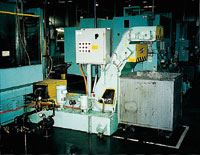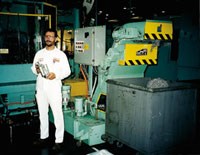Improving Quality, Productivity And Tool Life With High Performance Chip Handling
Continuous improvement--most of the time it is painstakingly slow...squeezing out small-tolerance refinements, fractions of more parts per hour or minor ergonomic enhancements. Rare are those instances where the improvements are significant, and they are even more exceptional when what happens is secondary to the project's intentions.
Share



Autodesk, Inc.
Featured Content
View More
Takumi USA
Featured Content
View More
Hwacheon Machinery America, Inc.
Featured Content
View More



Continuous improvement—most of the time it is painstakingly slow...squeezing out small-tolerance refinements, fractions of more parts per hour or minor ergonomic enhancements. Rare are those instances where the improvements are significant, and they are even more exceptional when what happens is secondary to the project's intentions. That's exactly what has played out at American Showa, Inc., a supplier to the automotive, motorcycle and marine industries. The company produces shock absorbing suspension components and front forks for automobiles and motorcycles, power steering units for vehicles and marine applications, and power tilt and trim mechanisms for boat motors.
According to production engineer Sam Shaaban at the company's Blanchester, Ohio, facility, American Showa wanted to modify the plant's floorplan in order to improve the physical flow between two machines that are designed to rough and finish the deep precision bores of two different cast aluminum housings. (American Showa casts the parts at the Blanchester facility.)
"Years ago, when the plant was set up, the two machines were placed close to one another because they were similar in design and machine similar parts through similar processes," says Mr. Shaaban. "After studying the situation, we decided that our workinprocess flow and inventory levels could be better served if the machining operations were separated and followed a more logistical path for each part and its subsequent operations. The move, however, entailed more than just physically relocating the machines. While each machine had its own auger mechanism for removing chips, both were tied together via a centralized drum-type "filtering' unit and overhead pipe coolant system." So in moving the machines, a new method for removing chips and cleaning the coolant had to be devised. The company was having difficulties in this area, too.
"Our major problem with the old chip and coolant system was that long, stringy chips produced in the process would tangle, become nests and grow to the point where the auger was useless. Or the auger would grind up the chips to such a small size that they would not be removed from the system. The operator associates would have to manually fork out and clean the machines," says Mr. Shaaban.
"We also had some foaming of the coolant in the overhead pipes as the filter drum became clogged with chips and restricted flow. We had three hoppers (one for the central system, one each for operators to load) taking up valuable floor space."
American Showa decided on the ConSep 2000, a chip separator conveyor/coolant filtration unit from Mayfran International (Cleveland, Ohio). The ConSep 2000 system is designed to replace traditional turning or machining chip conveyors. While it requires a little bit more space, it cleans and filters coolant at the same time. The basic unit, which can be easily modified to suit application heights and lengths, handles many types of swarf, including ferrous and nonferrous strings, turnings, fines, curls and nests.
The two ConSep 2000 units were delivered to American Showa, and the installation process was completed over a two-week period. The standard ConSep system consists of a hinged and perforated steel belt conveyor for larger chips and strings, plus a lower drag conveyor and filter drum for removal of fines. Large chips and strings are simply carried away to the chip discharge chute by the steel conveyor as coolant flows down to the lower area containing the drag conveyor and filter drum. The coolant is maintained at a level below the height of the steel conveyor, draining residual fluid from chips plus minimizing coolant foaming conditions and the problem of floating chips.
The filter unit separates fines to 50 micron nominal and features a self-cleaning, pressurized backwash for the drum's poly fiber media. After the backwash cycle, the lower conveyor then picks up and carries off the fines. The over/under location of the two discharge chutes allows chips and fines to be collected in the same hopper. The pressurized backwash system for the mesh filter means less downtime.
"We made one modification to each of the new systems," Mr. Shaaban states, "in that we salvaged two pumps from the old system and installed them as booster pumps in the coolant lines. With this addition, we're operating at up to 75 psi (previously, it was, at most, 50 psi) and pumping approximately 50 gallons per minute through each machine. The higher pressure helps to break the strings, and the volume assures that coolant is reaching cutting edges deep in the bores while each machine tool and fixture is flushed."
Since installation of the two ConSep 2000 units, now in operation for approximately one year, the primary concern at American Showa has been eliminated. "Virtually all of the chips, strings and nests are thoroughly flushed and carried away from the machines," says Mr. Shaaban. "Associates no longer have to take the time to manually clean the machines. But, after a year, the results in other areas that we did not fully anticipate have been even more dramatic. First, our tool life expectancy has increased. We used to run about 1,200 pieces before making tool changes; now that number averages 10,000 parts per tool. At the same time, we were able to increase feed rates, and the overall effect—between decreased downtime for tool changes and the faster feeds—has been a near doubling of our productivity. The old auger system had trouble handling 1.4 pounds of chips per hour; our new ConSep systems are removing up to 2.8 pounds.
"Since the installation, our scrap rate, typically resulting from unsatisfactory surface finishes, has decreased by 20 percent. Because no other changes were made other than the new chip handling and coolant cleaning, we assume that these productivity, quality and cost advantages are the result of cleaner, contaminate free coolant," Mr. Shaaban says.
Related Content
All World Machinery Coolant System Supports Deep-Hole Drilling
IMTS 2024: All World Machinery Supply introduces the self-cleaning SpindleShot high-pressure coolant system, with deep-hole drilling and assorted precision capabilities.
Read MoreBlaser Swisslube Coolant Minimizes Tool Wear When Machining Titanium
IMTS 2024: Skytec metalworking fluids are well suited for titanium machining because they minimize tool wear and reduce the number of tool changes without compromising process reliability.
Read MoreSTLE Opens Registration for 2024 Annual Meeting
The Society of Tribologists and Lubrication Engineers’ 2024 STLE Annual Meeting & Exhibition will take place May 19-23 at the Minneapolis Convention Center in Minneapolis, Minnesota.
Read MoreConsiderations for Machining Coolant Care
Coolant care can be simply managed if you know where to pay attention and which hazards to look out for.
Read MoreRead Next
Registration Now Open for the Precision Machining Technology Show (PMTS) 2025
The precision machining industry’s premier event returns to Cleveland, OH, April 1-3.
Read MoreSetting Up the Building Blocks for a Digital Factory
Woodward Inc. spent over a year developing an API to connect machines to its digital factory. Caron Engineering’s MiConnect has cut most of this process while also granting the shop greater access to machine information.
Read MoreBuilding Out a Foundation for Student Machinists
Autodesk and Haas have teamed up to produce an introductory course for students that covers the basics of CAD, CAM and CNC while providing them with a portfolio part.
Read More

















































